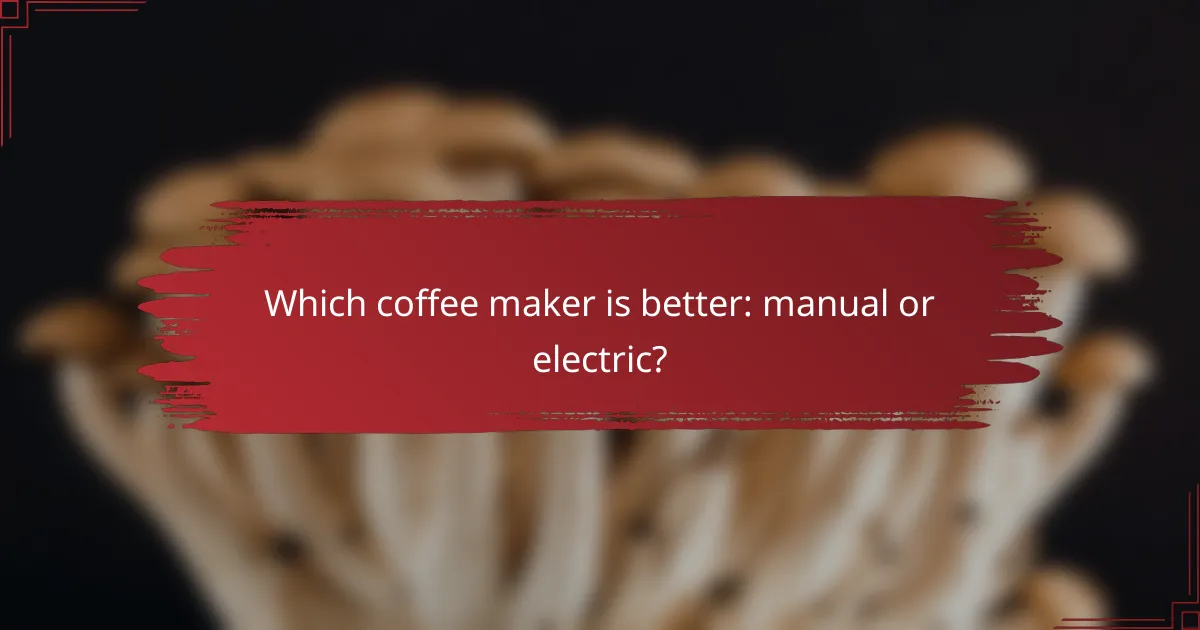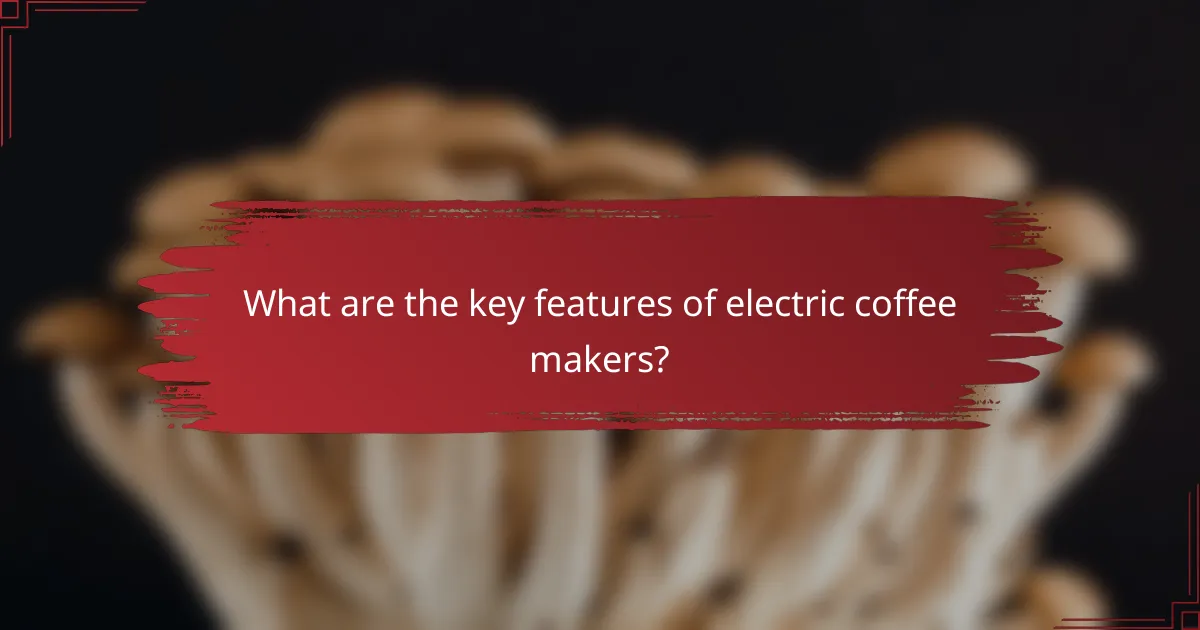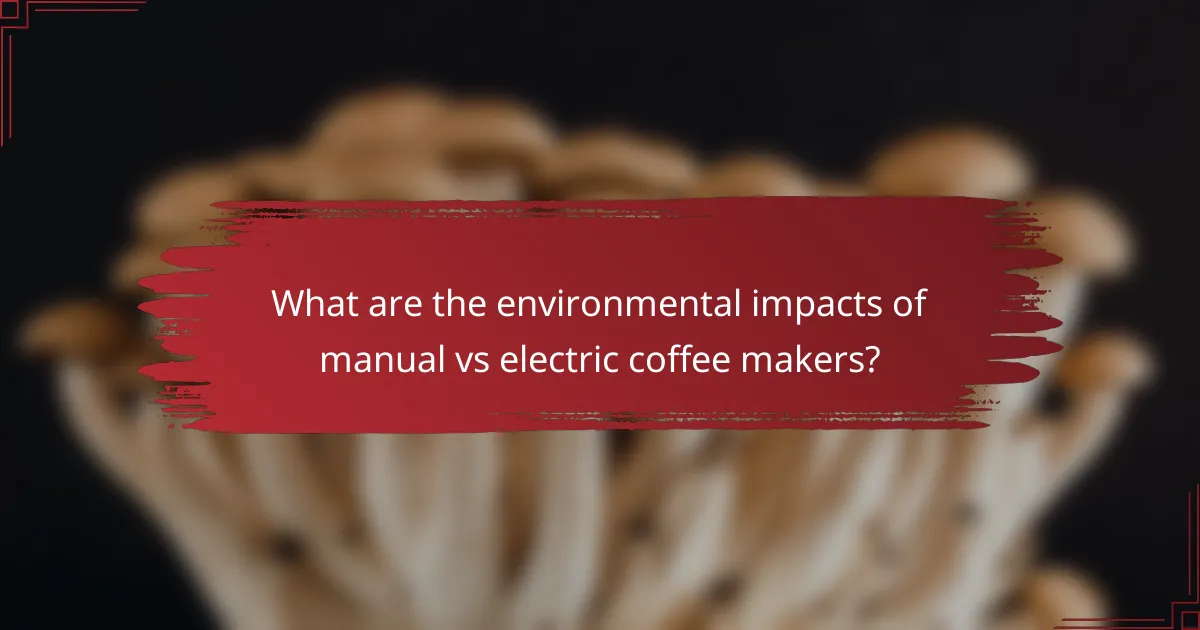When choosing between manual and electric coffee makers, it’s essential to consider your brewing preferences and lifestyle. Manual coffee makers provide a hands-on experience with customizable brewing parameters, while electric models focus on convenience and consistency, featuring programmable settings and automatic functions. Understanding these differences can help you select the perfect coffee maker to suit your needs.

Which coffee maker is better: manual or electric?
The choice between manual and electric coffee makers depends on your preferences for control and convenience. Manual options allow for greater customization, while electric models prioritize ease of use and speed.
Manual coffee makers offer more control
Manual coffee makers, such as pour-over and French press, give users the ability to fine-tune brewing variables like water temperature, grind size, and steeping time. This level of control can lead to a more personalized flavor profile, appealing to coffee enthusiasts who enjoy experimenting.
However, mastering manual brewing techniques requires practice and patience. Beginners may find the learning curve steep, but the reward is often a richer and more nuanced cup of coffee.
Electric coffee makers provide convenience
Electric coffee makers are designed for speed and ease, making them ideal for busy lifestyles. With features like programmable settings and automatic shut-off, they can brew coffee with minimal effort, often in just a few minutes.
While they may lack the customization of manual options, many electric models still offer settings for brew strength and temperature. This balance of convenience and flexibility makes them a popular choice for households and offices alike.
Cost differences between manual and electric
Generally, manual coffee makers tend to be less expensive than electric models, with prices ranging from low tens to a few hundred USD depending on the brand and complexity. Basic pour-over setups can be quite affordable, while high-end manual brewers can still be a fraction of the cost of premium electric machines.
Electric coffee makers, on the other hand, can vary widely in price, often starting around the mid-range and going up to several hundred USD for advanced features. When considering your budget, think about the long-term value of each type based on your coffee habits and preferences.

What are the key features of manual coffee makers?
Manual coffee makers offer a hands-on approach to brewing, allowing users to control every aspect of the process. Key features include simplicity, the ability to customize brewing parameters, and often a lower cost compared to electric models.
Types of manual coffee makers
Manual coffee makers come in various types, each with unique brewing methods. Common types include pour-over brewers, French presses, AeroPress, and siphon coffee makers. Each type offers different levels of control over brewing time and temperature, impacting the final flavor.
For example, a pour-over brewer allows for precise water flow and timing, while a French press provides a full-bodied taste due to its steeping method. Choosing the right type depends on personal preference and desired coffee characteristics.
Brewing techniques for manual coffee makers
Brewing with manual coffee makers involves several techniques that can affect the outcome. For instance, with a pour-over, the user must pour water in a circular motion to ensure even saturation of the coffee grounds. In contrast, a French press requires steeping the coffee for several minutes before pressing down the plunger.
It’s essential to experiment with grind size, water temperature, and brew time to find the perfect balance for your taste. A common guideline is to use a coffee-to-water ratio of about 1:15 for pour-over methods, while a 1:12 ratio works well for French presses.
Flavor profiles from manual brewing
Manual brewing techniques can produce distinct flavor profiles, often highlighting the coffee’s origin and characteristics. For example, pour-over methods tend to emphasize clarity and brightness, while French presses yield a richer, fuller body due to the immersion brewing process.
Experimenting with different beans and brewing methods can lead to discovering unique flavors. Consider trying single-origin coffees to appreciate the subtle differences that manual brewing can reveal, as these methods often bring out the nuances that automatic machines might overlook.

What are the key features of electric coffee makers?
Electric coffee makers are designed for convenience and consistency, offering features that simplify the brewing process. Key attributes include programmable settings, automatic shut-off, and built-in grinders, making them user-friendly and efficient for daily use.
Types of electric coffee makers
Electric coffee makers come in several types, each catering to different brewing preferences. Common types include drip coffee makers, single-serve machines, espresso machines, and French press electric models. Drip coffee makers are popular for their ability to brew multiple cups at once, while single-serve machines offer quick, individual servings.
Espresso machines provide a more concentrated coffee experience, ideal for those who enjoy specialty drinks. French press electric models combine traditional brewing with modern convenience, allowing users to enjoy rich flavors with minimal effort.
Brewing speed and efficiency
Electric coffee makers typically brew coffee faster than manual methods, with most models completing a full pot in about 5 to 10 minutes. Single-serve machines can brew a cup in under a minute, making them ideal for busy mornings. Efficiency varies by model, so consider the brewing capacity and time when choosing a machine.
Some electric coffee makers also feature quick brew options, which can reduce brewing time significantly. However, be cautious as faster brewing may sometimes compromise flavor quality.
Smart features in electric coffee makers
Many modern electric coffee makers include smart features that enhance user experience. These can range from Wi-Fi connectivity, allowing you to control brewing remotely, to programmable timers that let you wake up to freshly brewed coffee. Some models even offer app integration for personalized brewing preferences.
When selecting a coffee maker with smart features, ensure compatibility with your home network and consider whether these features align with your brewing habits. While they add convenience, they may also increase the initial cost of the machine.

How do manual and electric coffee makers compare in price?
Manual coffee makers typically have a lower upfront cost compared to electric coffee makers, which can be more expensive due to their added features and technology. However, the overall cost of ownership may vary based on usage and maintenance.
Price range for manual coffee makers
Manual coffee makers generally range from around $10 to $100. Basic models like pour-over or French press options are often at the lower end, while more sophisticated designs can approach the higher end of this spectrum. These devices usually require minimal maintenance and have no ongoing electricity costs.
Price range for electric coffee makers
Electric coffee makers typically range from approximately $30 to $300 or more. Entry-level drip coffee machines can be found for around $30, while high-end models with advanced features like programmable settings and built-in grinders can exceed $300. The price often reflects the complexity and convenience offered by these machines.
Long-term cost considerations
When considering long-term costs, electric coffee makers may incur additional expenses for electricity and maintenance. Depending on usage, the energy cost can add up, especially for models with heating elements that stay on for extended periods. In contrast, manual coffee makers have no energy costs, making them more economical over time.
Additionally, consider the cost of coffee and accessories. Manual brewers may require specific types of coffee grounds or filters, while electric machines might have compatible pods or proprietary filters that can increase ongoing expenses. Always evaluate the total cost of ownership when choosing between manual and electric options.

What are the maintenance requirements for each type?
Manual and electric coffee makers have distinct maintenance needs. Manual models typically require more frequent cleaning due to their design, while electric versions often have built-in features that simplify upkeep.
Cleaning manual coffee makers
Manual coffee makers, such as pour-over or French press, need regular cleaning to prevent coffee oils and residue buildup. After each use, rinse all components with hot water and let them dry thoroughly.
Every few weeks, consider a deeper clean using a mixture of vinegar and water to remove stubborn stains and odors. Avoid abrasive materials that can scratch surfaces.
Cleaning electric coffee makers
Electric coffee makers generally require less hands-on cleaning due to their automatic brewing systems. However, it’s essential to clean the carafe and filter basket after each use to maintain flavor quality.
Descaling should be done every one to three months, depending on water hardness. Use a commercial descaling solution or a vinegar-water mix to keep the internal components functioning optimally.
Durability and lifespan comparison
Manual coffee makers often have a longer lifespan since they have fewer electronic components that can fail. With proper care, they can last for many years, sometimes even decades.
Electric coffee makers, while convenient, typically have a shorter lifespan, averaging around five to ten years. Regular maintenance can extend their life, but wear and tear on electrical parts is inevitable.

What are the environmental impacts of manual vs electric coffee makers?
The environmental impacts of manual and electric coffee makers differ significantly, primarily in energy consumption and waste generation. While electric coffee makers typically require electricity, manual coffee makers often produce less waste but may involve more resource-intensive materials.
Energy consumption of electric coffee makers
Electric coffee makers consume energy during operation, which contributes to their overall environmental footprint. Depending on the model, they can use anywhere from 600 to 1,200 watts per brew cycle, translating to a few cents per cup based on local electricity rates.
To minimize energy use, consider using programmable features that allow the machine to turn off automatically after brewing. Opting for energy-efficient models that are certified by recognized standards can also help reduce consumption.
Waste generated by manual coffee makers
Manual coffee makers, such as French presses or pour-over systems, generally produce less electronic waste compared to their electric counterparts. However, they can still generate waste through coffee grounds and filters, which may not be compostable depending on the materials used.
To lessen waste, choose reusable filters or compostable options, and ensure proper disposal of coffee grounds by using them in gardens or as natural fertilizers. This approach not only reduces waste but also enhances sustainability in coffee consumption.

What are user preferences for coffee makers in major cities?
User preferences for coffee makers in major cities often lean towards convenience and efficiency. Many urban dwellers prioritize electric coffee makers due to their speed and ease of use, while some still appreciate the traditional appeal of manual brewing methods.
Popularity of Electric Coffee Makers
Electric coffee makers are favored for their quick brewing times and programmable features. Users in cities like New York and London often choose drip coffee machines or single-serve pod systems, which can brew a cup in just a few minutes. These machines typically range from affordable options around $30 to high-end models exceeding $300.
Convenience is a significant factor; many electric models come with built-in grinders and timers, allowing users to wake up to freshly brewed coffee. However, some users express concerns over the environmental impact of single-use pods and prefer machines that accommodate reusable filters.
Preference for Manual Coffee Makers
Manual coffee makers, such as pour-over and French press, attract users who value the brewing process and flavor control. In cities like Paris and Tokyo, coffee enthusiasts often invest in high-quality manual devices, appreciating the craftsmanship and the ability to experiment with different brewing techniques.
While manual methods can take longer, typically requiring several minutes, they allow for a more personalized coffee experience. Users often report that the taste of coffee brewed manually is superior, leading to a dedicated following despite the extra effort involved.
Factors Influencing Choices
Several factors influence the choice between manual and electric coffee makers, including lifestyle, budget, and taste preferences. Urban residents with busy schedules may gravitate towards electric options for their speed, while those who enjoy the ritual of brewing might prefer manual methods.
Price is another consideration; electric coffee makers can vary widely in cost, while manual brewers often offer a more budget-friendly entry point. Additionally, the availability of space in small city apartments can affect decisions, as some manual devices require less counter space than bulky electric machines.



